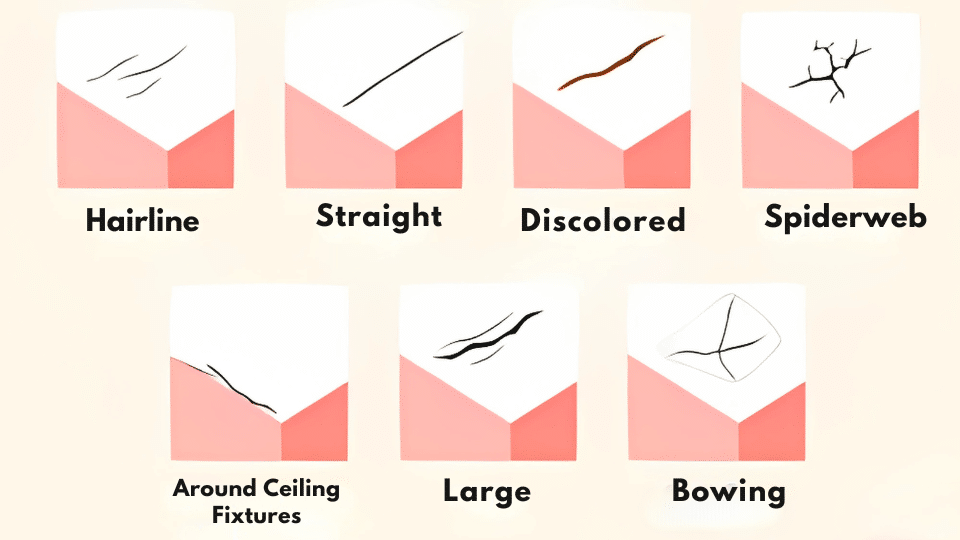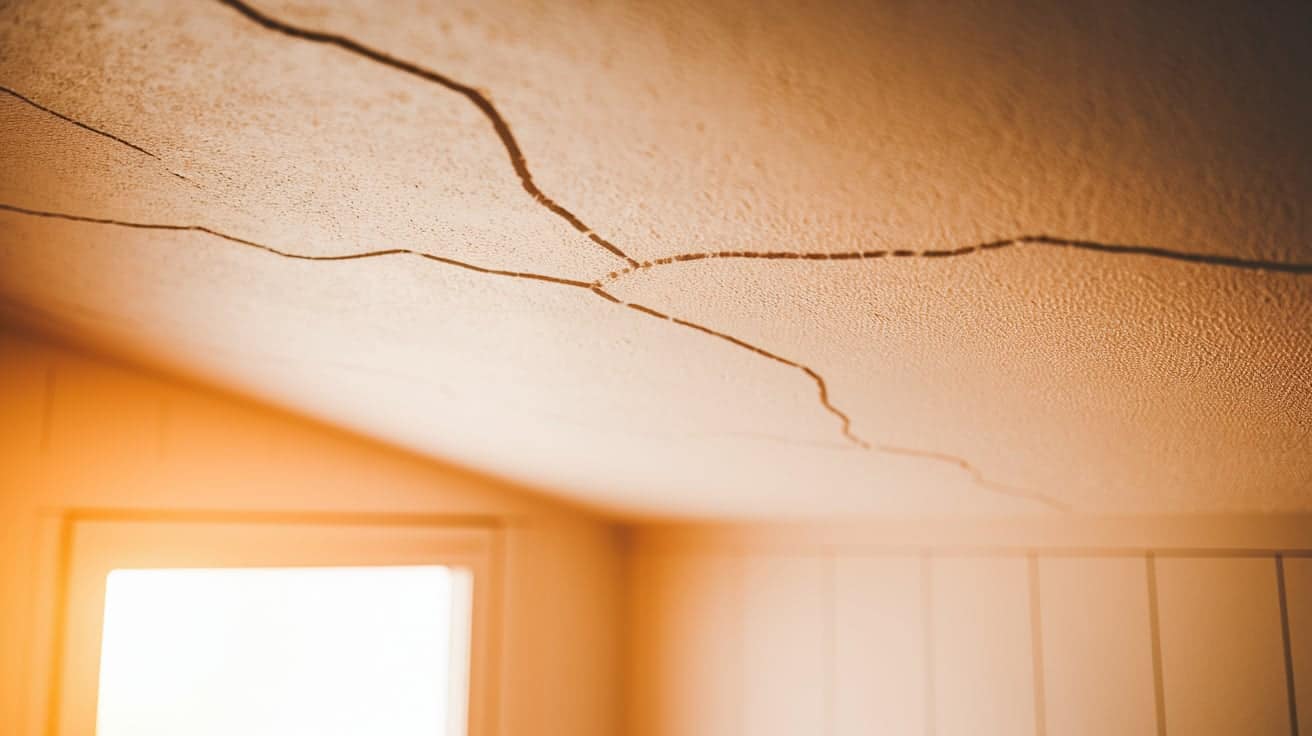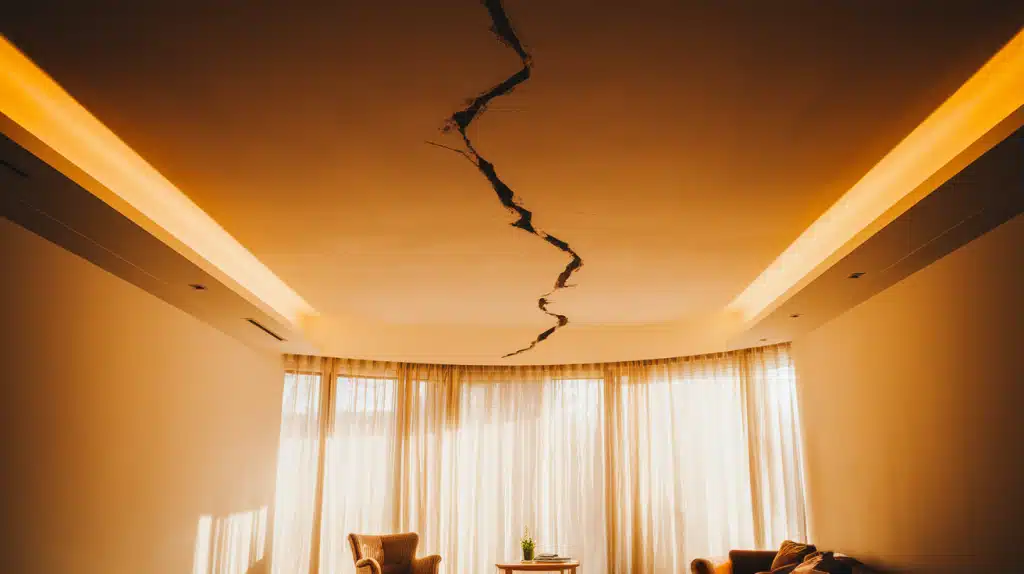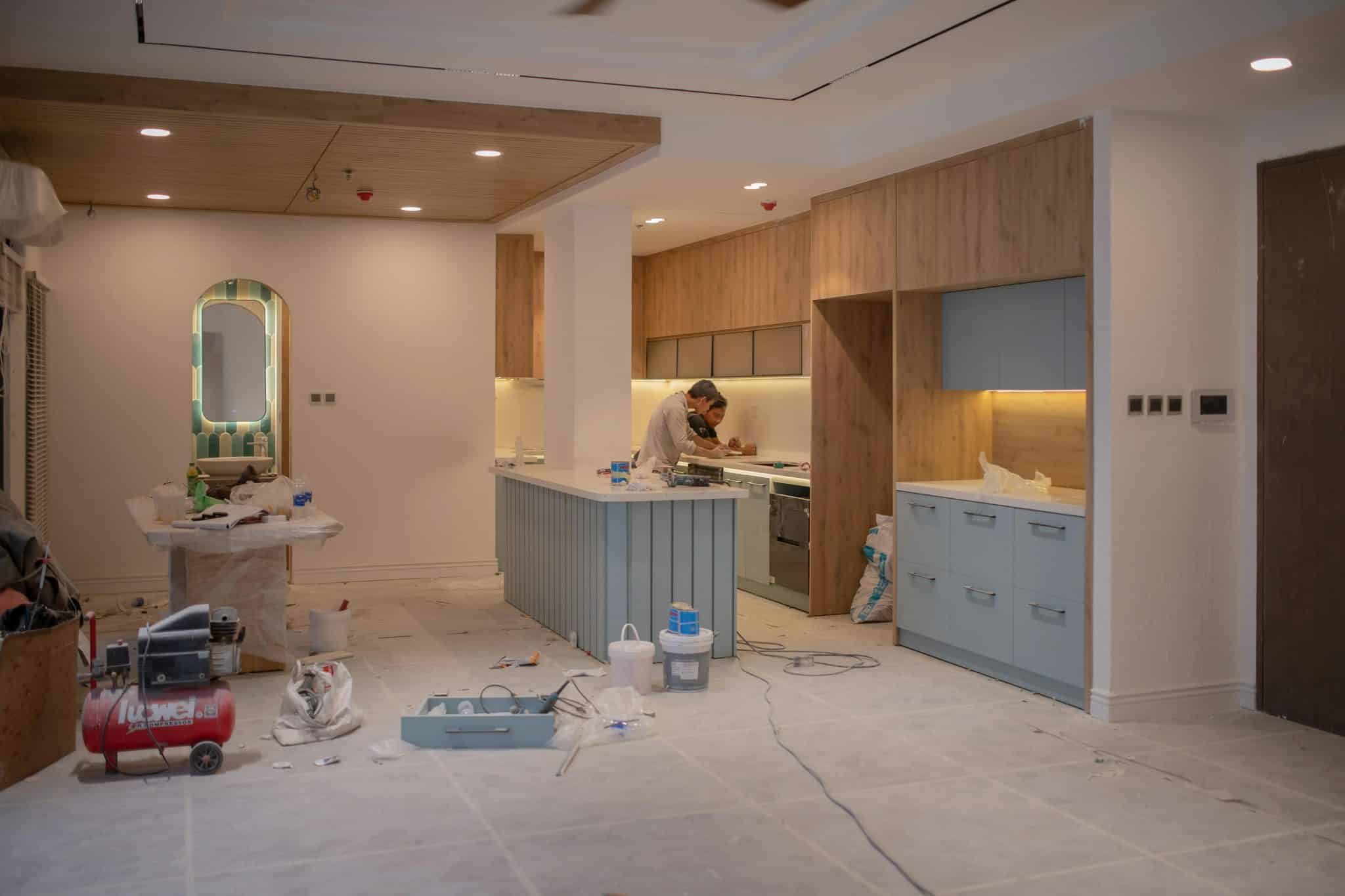You’re lying in bed when you notice a thin line running across your ceiling. Your mind starts racing. Is this just regular wear and tear, or could your ceiling collapse?
Most homeowners feel this exact worry when they spot their first ceiling crack.
The truth is, while many ceiling cracks are harmless cosmetic issues, others can signal serious structural problems, water damage, or safety hazards that need immediate attention.
We’ll help you identify the difference between safe and dangerous ceiling cracks so you can protect your home and family.
This guide covers the most common types of ceiling cracks, their causes, risk levels, and exactly when to call a professional versus handling repairs yourself.
What Are Ceiling Cracks?
Ceiling cracks are splits or lines that appear in your ceiling’s surface material, whether it’s drywall, plaster, or paint. These visible breaks act like your home’s way of telling a story about what’s happening behind the scenes.
Some cracks are simply part of normal house settling, much like wrinkles that naturally develop as your home ages and materials expand or contract due to temperature changes.
However, other cracks can signal serious issues, such as water damage, structural problems, or foundation movement, that require immediate attention. The key is learning to read what your ceiling is trying to tell you.
Hairline Dangerous Ceiling Cracks Causes
- Foundation settling and soil movement: When your home’s foundation shifts due to changes in soil, drought, or poor drainage, the entire structure moves, creating stress cracks in the ceilings.
- Water damage from plumbing, HVAC, or roof leaks: Moisture from burst pipes, leaking roofs, or condensation problems weakens ceiling materials, causing them to crack and sag.
- Humidity and seasonal expansion: Temperature and moisture changes cause building materials to expand and contract, creating stress that shows up as ceiling cracks.
- Heavy fixtures or attic storage: Excessive weight from large ceiling fans, chandeliers, or excessive storage in the attic can overload ceiling supports and cause cracking.
- Aging materials and poor construction: Old plaster, cheap materials, or shortcuts during original construction eventually fail and develop cracks as the building ages.
7 Common Types of Ceiling Cracks

1. Hairline Cracks
These ultra-thin cracks are barely visible to the naked eye. They typically measure less than 1/16 inch in width and resemble fine pencil lines drawn across your ceiling. Most hairline cracks develop when paint or plaster shrink as they dry and cure.
You’ll often spot them in newly built homes or rooms that were just painted or renovated. While they may appear concerning, hairline cracks are typically cosmetic issues that don’t compromise your home’s structural integrity.
2. Straight Line Cracks
These cracks run in perfectly straight lines across your ceiling, usually following where drywall sheets meet or where tape was applied. They’re caused by normal house settling or seasonal temperature changes that make materials expand and contract.
You might notice them appearing during winter heating or summer cooling seasons. Straight-line cracks are typically not dangerous, but they can be annoying if they recur after repairs.
3. Spiderweb or Alligator Cracks
These cracks spread out from a central point, resembling a spider’s web, or form scale-like patterns similar to alligator skin. Small spiderweb cracks are often just signs of aging plaster or paint.
However, large patterns covering several square feet might indicate foundation settling or structural movement. Please pay attention to the size of minor web patterns; they are usually cosmetic, but extensive networks need professional evaluation.
4. Discolored Cracks with Stains
When you see brown, yellow, or rust-colored stains around ceiling cracks, water damage is the culprit. These discolored edges are clear warning signs that moisture is actively leaking into your ceiling materials.
The source could be a roof leak, burst pipe, or HVAC condensation problem. This type requires immediate action; the longer water sits, the more damage it causes to your home’s structure and the higher the risk of mold growth.
5. Cracks Around Ceiling Fixtures
These cracks appear near or around ceiling lights, fans, or HVAC vents. They often form because the fixture is too heavy for the mounting method used, or the installation created stress points in the ceiling material.
Sometimes they develop when fixtures vibrate (like ceiling fans) or when HVAC systems cause temperature fluctuations.
6. Bowing Cracks
When ceiling cracks accompany visible sagging, dipping, or bulging areas, you’re looking at a high-risk situation. The ceiling structure itself is failing, which could be due to rotted joists, water saturation, or excessive weight from attic storage.
This combination of cracking and bowing often occurs gradually, then worsens suddenly.
7. Large or Jagged Cracks
These are the ceiling cracks that demand immediate attention. Any crack wider than 1/8 inch or with jagged, uneven edges signals serious structural stress. Unlike neat hairline cracks, these look rough and irregular. They often appear suddenly after events like earthquakes, major storms, or significant foundation shifts.
Top 10 Risks and Dangers of Ceiling Cracks
Ceiling cracks aren’t just unsightly; they can signal serious underlying issues like structural failure, water damage, or electrical hazards. Here are the top 10 risks you need to know to protect your home and safety.
1. Structural Instability
Wide cracks that keep growing are your ceiling’s cry for help. When ceiling joists or support beams start failing, the entire structure above becomes unstable. You might notice the ceiling sagging or feeling “bouncy” when you walk on the floor above.
This type of damage can lead to sudden ceiling collapse, especially if there’s weight from furniture, water, or people in the attic. Never ignore cracks wider than 1/8 inch or any crack that’s getting bigger.
2. Water Damage and Mold Growth
Those brown or yellow stains around ceiling cracks aren’t just ugly – they’re warning signs of active water intrusion. Moisture seeping through cracks creates the perfect breeding ground for mold and mildew within 24-48 hours.
Once mold takes hold in your ceiling materials, it spreads quickly and releases spores into your home’s air. This can trigger allergies, asthma attacks, and other respiratory problems for your family. Water-stained cracks need immediate attention to prevent health risks.
3. Electrical Hazards
Ceiling cracks near light fixtures or electrical outlets can become deadly when water gets involved. Even small amounts of moisture can cause electrical shorts, sparks, or fires inside your ceiling.
You might notice lights flickering, outlets not working, or even a burning smell. Water damage to electrical systems often occurs gradually, making it difficult to detect until it becomes hazardous. Turn off the electricity to affected areas and call an electrician immediately if you suspect water near wiring.
4. Pest Intrusion
Even tiny ceiling cracks become highways for insects, spiders, and small rodents. Mice can squeeze through cracks as small as 1/4 inch, while insects need even less space.
Once inside your ceiling, pests can nest in insulation, chew through wires, and spread throughout your home. You might hear scratching sounds at night or notice droppings in your attic. Seal cracks quickly to prevent pest problems from getting out of control.
5. Falling Debris
When ceiling materials start separating due to deep cracks, pieces can fall without warning. Plaster chunks, drywall sections, or even light fixtures can drop onto furniture, beds, or people below.
This risk is especially high in older homes with heavy plaster ceilings. You might notice small pieces of debris on the floor as an early warning sign. Move furniture and avoid spending time under areas with cracks until repairs are made.
6. Hidden Leaks and Plumbing Issues
Ceiling cracks in bathrooms, kitchens, or laundry rooms often conceal more significant issues above. Slow plumbing leaks can rot wooden ceiling joists and create extensive damage before you notice any visible signs.
These hidden leaks waste water, increase utility bills, and can weaken your home’s structure over time. By the time water damage becomes visible, the repair costs can often exceed thousands of dollars. Check your attic regularly for signs of moisture if you have ceiling cracks near plumbing.
7. Foundation or Settlement Problems
Jagged ceiling cracks that seem to point toward walls often indicate your home’s foundation is shifting or settling unevenly. This type of movement affects your entire house, not just the ceiling.
You might notice doors sticking, windows not closing properly, or new cracks appearing in walls. Foundation problems get more expensive to fix the longer you wait. Contact a structural engineer if ceiling cracks appear suddenly or follow a consistent pattern throughout your home.
8. Decline in Property Value
Ceiling cracks are among the first things potential buyers notice during home tours. Even small cosmetic cracks can raise red flags about maintenance and structural integrity.
Home inspectors will document every crack, and buyers often demand repairs or price reductions before closing. Major ceiling damage can make your home difficult to sell or require expensive fixes before listing. Address visible ceiling cracks before listing your home for sale.
9. Insulation and Energy Loss
Ceiling cracks, especially around light fixtures or attic access points, let conditioned air escape from your home. Your heating and cooling system must work harder to maintain comfortable temperatures, resulting in higher energy bills.
In winter, warm air rises and escapes through ceiling cracks, while in summer, cool air is lost the same way. Poor insulation around cracks also allows outside air to enter your living spaces. Sealing ceiling cracks can improve energy efficiency and lower monthly utility costs.
10. Cosmetic Degradation Leading to Deeper Damage
What starts as a tiny hairline crack can quickly develop into a major repair project if left unattended. Temperature changes, humidity, and normal house movement can cause small cracks to grow larger over time.
Paint begins peeling around crack edges, drywall tape fails, and eventually, the underlying structure becomes damaged. The cost difference between fixing a small crack and replacing an entire ceiling section can be thousands of dollars. Regular maintenance and prompt crack repair prevent minor issues from becoming major headaches.
Conclusion
Not every ceiling crack means your home is falling apart, but none should be ignored entirely, either. The key takeaway is learning to read what your ceiling is trying to tell you.
Hairline cracks are usually just cosmetic annoyances, while wide, stained, or growing cracks demand immediate professional attention.
So what’s next? Start by taking photos of any ceiling cracks in your home and measuring their width. Monitor them monthly to see if they’re growing or changing. Remember, catching problems early saves you thousands in repair costs and keeps your family safe from potential hazards, such as falling debris or structural collapse.
When in doubt, contact a structural engineer or qualified contractor for a professional evaluation.
What ceiling cracks have you noticed in your home? Share your experiences in the comments below, and don’t hesitate to seek professional help if something doesn’t look right.









